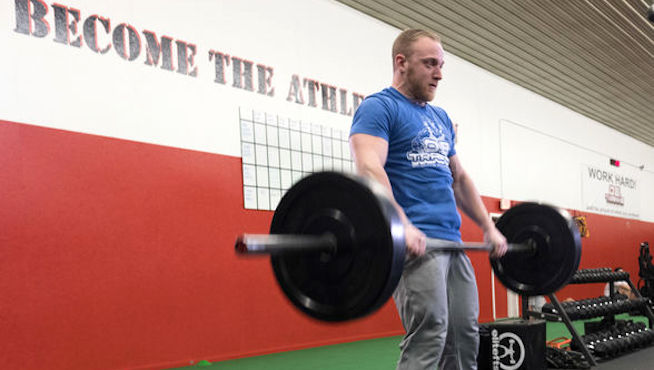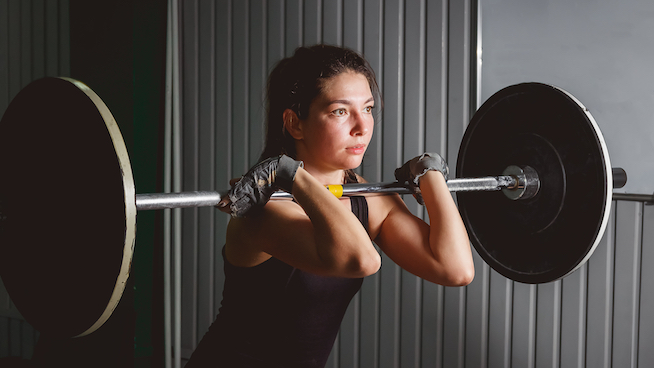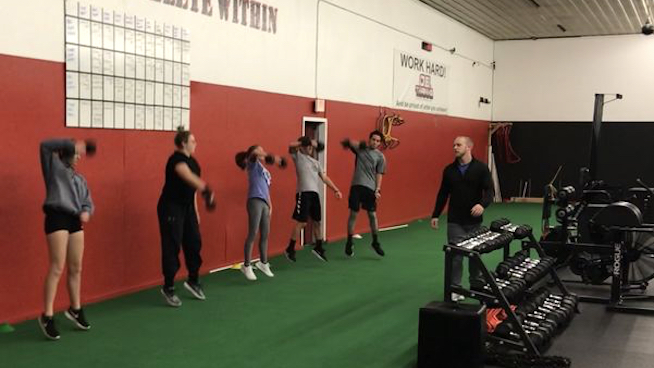The Secret to Jumping Higher Without Any Jump Training
Just about every athlete wants to be able to jump higher.
Having the best vertical jump is a desire that’s engrained in athletes from a very young age. Not only is it an awesome display of athleticism, but it can prove very beneficial to your sports performance. I can remember rigging up bungee cords to our swing set when I was a kid just so I could jump higher. I didn’t realize it at the time, but I was actually training myself with accelerated jump training.
Overall, the most popular method that athletes use to train their vertical jump is to jump, and rightfully so. However, there are other ways you can rapidly increase your vertical. One of the best methods? Olympic Weightlifting.
Some of the most powerful athletes in the world are olympic weightlifters. When you break it down—anOolympic weightlifter lifts hundred of pounds from the floor and then jumps with it. To be able to do that, you have to be able to generate a freaky amount of power, which translates to a big vertical jump. In the 1980s, a study done by John Garhammer measuring the power output of Olympic weightlifters showed that lifters would produce up to 4,500 watts during certain phases of a lift. To give you comparison, the power generated during a 1,000-pound Deadlift is only about 800 watts. In a 2014 study, it was also found that the Power Clean movement produced forces that were five times greater than those generated during a vertical jump.
The Clean and the Snatch are two of the very few movements where an athlete executes a true powerful triple extension pattern (simultaneous extension at the ankle, knee and hip). When the athlete moves the bar from the floor through the first and second pull, they essentially perform a variation of a weighted jump without loading the spine in a dangerous manner.
How effective is Olympic weightlifting for jumping higher?

In a 2005 study entitled “Short-term effects on lower-body functional power development: weightlifting vs. vertical jump training programs,” researchers found that participants who followed an eight-week olympic weightlifting program outperformed those who followed a jump-specific training program in Vertical Jump tests as well as other tests of power.
Granted, this is only one study, but it provides evidence that olympic weightlifting can be used as an effective training method for improving vertical jump. As a personal anecdote, after training on a 12-week Olympic weightlifting program with zero jump training, I was able to hit a 58-inch box jump, my highest jump ever.
Why don’t more athletes use Olympic weightlifting to jump higher?

The most common reason athletes don’t use Olympic weightlifting is the level of technical difficulty that these moves present. The Snatch and the Clean & Jerk are two of the most technically complex movements an athlete can learn in a weight room. From a coaching perspective, this means there can be a big time commitment in properly teaching and coaching athletes to perform these lifts correctly and effectively. Any athlete can jump, but not every athlete can hit a Clean with stellar form.
How do you beat that learning curve?
To overcome the sometimes steep learning curve that accompanies Olympic lifts, the first step is patience.
Learning to perform these complex lifts properly takes a lot of time, focus and dedication to perfecting the basic positions. This means that the athlete needs to be willing to be patient and embrace the process. Repetition is king. A great way to get in a lot of reps for the basic positioning and technique work is to make it a part of your daily warm-up. This guarantees that every day you get a little more practice in “handling” the bar.
The second step is starting young.
If I could change one thing from my earlier training days, it would have been to learn the Olympic lifts. The movements create overall “athletic” bodies and they’re also a great tool for staying mobile. Get started as soon as possible, and if you have athletes that you’re working with, start them young.
The final step is to make use of different variations.
A great way to learn the lifts is to break down the movements into their individual parts. A “Snatch Pull” can generate some of the highest outputs amongst all the lifts and has very little risk to the lifter since there is no catch portion to the lift. For those who aren’t very mobile, try using dumbbells or kettlebells to develop the basic patterning and feel for generating power with the hips. This concept is usually the aha! moment for athletes when learning these Olympic lifts. The faster you understand the idea of snapping the hips and getting them to “pop,” the more power you will be able to generate in your jumps and your lifts.
Photo Credit: Adam J. Brockway, FotoKOT/iStock
READ MORE:
RECOMMENDED FOR YOU
MOST POPULAR
The Secret to Jumping Higher Without Any Jump Training
Just about every athlete wants to be able to jump higher.
Having the best vertical jump is a desire that’s engrained in athletes from a very young age. Not only is it an awesome display of athleticism, but it can prove very beneficial to your sports performance. I can remember rigging up bungee cords to our swing set when I was a kid just so I could jump higher. I didn’t realize it at the time, but I was actually training myself with accelerated jump training.
Overall, the most popular method that athletes use to train their vertical jump is to jump, and rightfully so. However, there are other ways you can rapidly increase your vertical. One of the best methods? Olympic Weightlifting.
Some of the most powerful athletes in the world are olympic weightlifters. When you break it down—anOolympic weightlifter lifts hundred of pounds from the floor and then jumps with it. To be able to do that, you have to be able to generate a freaky amount of power, which translates to a big vertical jump. In the 1980s, a study done by John Garhammer measuring the power output of Olympic weightlifters showed that lifters would produce up to 4,500 watts during certain phases of a lift. To give you comparison, the power generated during a 1,000-pound Deadlift is only about 800 watts. In a 2014 study, it was also found that the Power Clean movement produced forces that were five times greater than those generated during a vertical jump.
The Clean and the Snatch are two of the very few movements where an athlete executes a true powerful triple extension pattern (simultaneous extension at the ankle, knee and hip). When the athlete moves the bar from the floor through the first and second pull, they essentially perform a variation of a weighted jump without loading the spine in a dangerous manner.
How effective is Olympic weightlifting for jumping higher?

In a 2005 study entitled “Short-term effects on lower-body functional power development: weightlifting vs. vertical jump training programs,” researchers found that participants who followed an eight-week olympic weightlifting program outperformed those who followed a jump-specific training program in Vertical Jump tests as well as other tests of power.
Granted, this is only one study, but it provides evidence that olympic weightlifting can be used as an effective training method for improving vertical jump. As a personal anecdote, after training on a 12-week Olympic weightlifting program with zero jump training, I was able to hit a 58-inch box jump, my highest jump ever.
Why don’t more athletes use Olympic weightlifting to jump higher?

The most common reason athletes don’t use Olympic weightlifting is the level of technical difficulty that these moves present. The Snatch and the Clean & Jerk are two of the most technically complex movements an athlete can learn in a weight room. From a coaching perspective, this means there can be a big time commitment in properly teaching and coaching athletes to perform these lifts correctly and effectively. Any athlete can jump, but not every athlete can hit a Clean with stellar form.
How do you beat that learning curve?
To overcome the sometimes steep learning curve that accompanies Olympic lifts, the first step is patience.
Learning to perform these complex lifts properly takes a lot of time, focus and dedication to perfecting the basic positions. This means that the athlete needs to be willing to be patient and embrace the process. Repetition is king. A great way to get in a lot of reps for the basic positioning and technique work is to make it a part of your daily warm-up. This guarantees that every day you get a little more practice in “handling” the bar.
The second step is starting young.
If I could change one thing from my earlier training days, it would have been to learn the Olympic lifts. The movements create overall “athletic” bodies and they’re also a great tool for staying mobile. Get started as soon as possible, and if you have athletes that you’re working with, start them young.
The final step is to make use of different variations.
A great way to learn the lifts is to break down the movements into their individual parts. A “Snatch Pull” can generate some of the highest outputs amongst all the lifts and has very little risk to the lifter since there is no catch portion to the lift. For those who aren’t very mobile, try using dumbbells or kettlebells to develop the basic patterning and feel for generating power with the hips. This concept is usually the aha! moment for athletes when learning these Olympic lifts. The faster you understand the idea of snapping the hips and getting them to “pop,” the more power you will be able to generate in your jumps and your lifts.
Photo Credit: Adam J. Brockway, FotoKOT/iStock
READ MORE:











